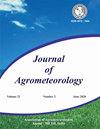Blue and green water footprint assessment of rice crop in high altitude temperate zone of Kashmir, India
Q3 Agricultural and Biological Sciences
引用次数: 0
Abstract
The water footprint (WF) for rice has been calculated from 2010 to 2022 for three different districts viz Anantnag, Budgam and Baramulla representing three different climatic regions of Kashmir valley. CROPWAT 8.0 model was used to calculate effective rainfall, reference evapotranspiration (ETo), crop evapotranspiration (ETc), and thereby the green and blue water footprint of rice was determined. ET0 was 117-133 mm in Budgam district, 100-112 mm in Baramulla district and 143-155 mm in Anantnag district. ETc in Budgam was found in the range of 136-149 m3ha-1, in Baramulla district it was found in the range of 115-140 m3ha-1 and in Anantnag district it was highest of the three districts ranging from 163-178 m3ha-1.The results showed that the WF was the highest (3444 l kg-1) in Baramulla district followed by 2300 l kg-1 in Anantnag and 2003 l kg-1 in Budgam districts. The share of green and blue components of WF (WFgreen and WFblue) also varied with the locations and in years. WFgreen and WFblue contributed more or less equally in Baramulla district, 68% and 32% respectively in Burmuda district and 60% and 40 % in Anantnag districts respectively.印度克什米尔高海拔温带地区水稻作物的蓝色和绿色水足迹评估
从 2010 年到 2022 年,对代表克什米尔山谷三个不同气候区的三个不同地区(即安南塔纳格、布德加姆和巴拉穆拉)的水稻水足迹(WF)进行了计算。利用 CROPWAT 8.0 模型计算了有效降雨量、参考蒸散量(ETo)和作物蒸散量(ETc),从而确定了水稻的绿色和蓝色水足迹。布德加姆地区的 ET0 为 117-133 毫米,巴拉穆拉地区为 100-112 毫米,安南塔纳格地区为 143-155 毫米。结果显示,巴拉穆拉地区的水耗量最高(3444 升/千克-1),其次是安南塔纳格地区的 2300 升/千克-1 和布加姆地区的 2003 升/千克-1。水样中绿色和蓝色成分(绿色水样和蓝色水样)所占的比例也因地点和年份而异。在巴拉穆拉县,WFgreen 和 WFblue 的比例大致相同,在布尔穆达县分别为 68% 和 32%,在安南塔纳格县分别为 60% 和 40%。
本文章由计算机程序翻译,如有差异,请以英文原文为准。
求助全文
约1分钟内获得全文
求助全文
来源期刊

Journal of Agrometeorology
农林科学-农艺学
CiteScore
1.40
自引率
0.00%
发文量
95
审稿时长
>12 weeks
期刊介绍:
The Journal of Agrometeorology (ISSN 0972-1665) , is a quarterly publication of Association of Agrometeorologists appearing in March, June, September and December. Since its beginning in 1999 till 2016, it was a half yearly publication appearing in June and December. In addition to regular issues, Association also brings out the special issues of the journal covering selected papers presented in seminar symposia organized by the Association.
 求助内容:
求助内容: 应助结果提醒方式:
应助结果提醒方式:


